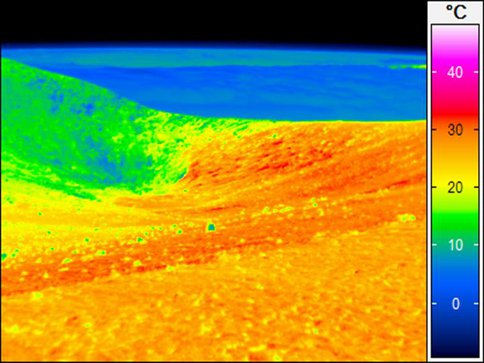2012 Annual Science Report
 University of Hawaii, Manoa
Reporting | SEP 2011 – AUG 2012
University of Hawaii, Manoa
Reporting | SEP 2011 – AUG 2012
Permafrost in Hawaii
Project Summary
Permanent ice can be found on the Hawaiian Islands at extremely few locations and as a result of microclimates. Ice exists in the form of permafrost in craters near the summit of Mauna Kea and in form of ice lakes in lava tubes on Mauna Loa; they are the world’s most isolated ice caves. We investigate the microclimates on the high summits of the Hawaiian Islands that serve as possible analogues to Mars. Exploratory fieldwork has been carried out at four field sites and interdisciplinary collaborations have been developed.
Project Progress
We have visited and documented two high-altitude ice caves on Mauna Loa. The caves are at ~3,500m elevation in unvegetated lava flows about 700 years old, which places a maximum age on the ice. The lava tubes of both caves are several hundred meters long and slope downhill; hence cold air sinks into the cave. The ice is in the form of frozen ponds; water drips from the ceiling and freezes in layers. The ponds are several tens of meters long, and we estimate them to be a few meters deep. Large cm-sized bubbles are included in the ice, as expected for very low freezing rates. The ice appears to be layered, and thus the ponds may contain a record of the past. We have drawn up cave maps and started temperature and humidity time series and ice level monitoring.
Mauna Kea is located in the tropics (19°N), but the climate on the summit is classified as an alpine desert. Permafrost can be found in at least two of the cinder cones near the summit. The low annual mean temperatures necessary for the ice to last all year round are caused by shadowing by the crater rim and by nocturnal cold air lakes. We have placed several data loggers in the two cinder cones to begin a temperature time series and equipped an infrared camera with a time-lapse circuit for infrared imaging of the crater interiors. These measurements will be compared to numerical models of the thermal environment to better understand the microclimates in the craters.
An infrared image of the Summit Cone Crater on Mauna Kea taken in spring at 10:53am. Permafrost lies beneath the coldest regions of the crater. At night, temperature can fall to -13°C. Temperature heterogeneity on the scale of individual rocks is visible in the foreground.
-
PROJECT INVESTIGATORS:
-
PROJECT MEMBERS:
Norbert Schorghofer
Project Investigator
Kenji Yoshikawa
Co-Investigator
Jocelyne DiRuggiero
Collaborator
Christopher McKay
Collaborator
Andreas Pflitsch
Collaborator
Scott Rowland
Collaborator
Stephen Smith
Collaborator
Thorsteinn Thorsteinsson
Collaborator
Brendan Hermalyn
Postdoc
Alberto Robador
Postdoc
-
RELATED OBJECTIVES:
Objective 2.1
Mars exploration.
Objective 5.3
Biochemical adaptation to extreme environments
Objective 6.2
Adaptation and evolution of life beyond Earth
